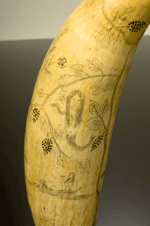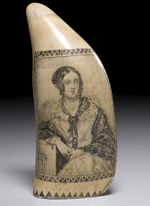|
Cowan's Corner
19th Century
Sailor Art is a Hot
Collecting Market
By Wes Cowan
At one time, New Bedford,
Mass., was known as the city
that lit the world. No more.
Today, New Bedford, like
many New England towns,
has fallen on hard times.
It’s still the home to great
museums and is blessed with
its deep water harbor, but its
19th Century moniker is a
thing of the past.
During the first half
of the 19th Century, New
Bedford was the home of
the American whaling fleet.
Whaling ships left port for
voyages that lasted as long
as four years and came home
laden with oil extracted from the flesh of mammoth
cetaceans. Fortunes were
made from this oil which,
while used in lighting,
was far more valuable as
a lubricant for machinery.
Until oil was discovered
in Pennsylvania in the late
1860s, whales provided most
of the oil for the machinery
of the Industrial Revolution.
This discovery of oil, along
with declining cetacean
populations, spelled the end
of the whaling industry.
Life on a whale ship is
probably best described as
one of intense periods of
boredom interspersed with
brief interludes of excitement
and hard, grinding work.
Sailors on a whaling voyages
could be gone from home for
periods of three, or even four
years, and most of this time
was spent traveling to and
from the whaling grounds
in the North Atlantic, South
Pacific or Arctic regions. It
was during this down time
that sailors made mementos of
their voyage and sentimental
tokens for loved ones utilizing
the durable teeth, bones and
other products of the whales they hunted and killed.
Utilizing sharp steel-steeltipped
awls, sailors engraved
whales’ teeth and bones with
various scenes and figures,
sculpting them into all sorts
of useful tools and fanciful
objects with knives and
other tools. Today, this group
of antiques is known as
“scrimshaw” and the sailor
artists as “scrimshanders”.
Collectors have long prized
the maritime mementos,
and pay large sums for great
examples. While an average
tooth might fetch prices in
the low hundreds, important
examples of scrimshawed
teeth, those from important
whaling ships or that feature
exquisite engraving, have
sold for as much as six
figures.
The most valuable examples of scrimshaw are those produced during the first half of the 19th Century. By the 1860s, whale populations had been decimated by over-hunting, and with the discovery of land-based petroleum, the whaling industry went into a decline from which it never recovered.
The art of the scrimshander died a fairly rapid death. While contemporary scrimshanders still exist, they primarily work with teeth imported from whales hunted by the Russians and Japanese. It is illegal to import the teeth or products of many whales and marine mammals, and collectors should be aware of not only national, but also state laws regulating the sale of the by-products of these magnificent mammals.
 About the author: Wes Cowan is founder and owner of Cowan’s Auctions, Inc. in Cincinnati, Ohio. An internationally recognized expert in historic Americana, Wes stars in the PBS television series History Detectives and is a featured appraiser on Antiques Roadshow. He can be reached via email at info@cowans.com. About the author: Wes Cowan is founder and owner of Cowan’s Auctions, Inc. in Cincinnati, Ohio. An internationally recognized expert in historic Americana, Wes stars in the PBS television series History Detectives and is a featured appraiser on Antiques Roadshow. He can be reached via email at info@cowans.com.
|

A scrimshaw whale
tooth engraved with a
mermaid and flags; $1,495
in Cowan’s Feb. 2006
Decorative Arts Auction.

A fine example of a pie crimper, or “jagger,” made from whale bone and whale
ivory; $2,760 in Cowan’s Feb. 2005 Decorative Arts Auction.

A Continental whale’s tooth
engraved with a portrait of a
lady; $3,408 in Cowan’s Feb. 2009
Decorative Arts Auction.
|